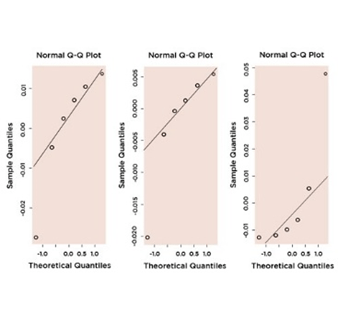
Meta-analysis of Convolutional neural networks for radiological images
October 30, 2020
Systematic Review of Network Analyst for Bioinformatics Visualization
November 9, 2020In-Brief:
- The specific goals of meta-analysis include the estimation of an overall effect using different studies.
- The use of multiple studies provides a more robust test of the statistical use of the effect; and identification of variables affecting the estimated impact in different studies.
- Among all the difficulties in using Meta Analysis, heterogeneity problems due to combining not similar studies and systematic trials due to biases or low quality of reviews is more difficult with fixed effect assumptions model given by Pubrica blog by Meta-analysis Writing Services.
Introduction
In statistical analysis, a fixed-effects model is a statistical model in which the model parameters are fixed quantities. It is in opposite to random-effects modelsin which all or some of the model parameters contain random variables. In many applications, including economicsand biostatistics fixed-effects model refers to a regression model in which group means fixagainst to random-effects model in which group means are a random sample from the population. Generally, the data groups, according to several experimental factors. The group means you can be model as fixed or random effects for each grouping. In panel data, longitudinal observations exist for the same subject. Fixed data effects represent the particular subject means. The panel data analysis the term fixed effects estimator refers to an estimator for the coefficients in the fixed effect regression model in meta-analysis paper writing
Qualitative description of fixed-effect regression
Writing a meta analysis models assist in controlling for left out variable bias due to unobserved heterogeneity when this heterogeneity is constant over timethat removes from the data through difference. e.g. subtracting the group-level average over time, or by taking a first difference which will remove any time-invariant components of the model.
There are two common assumptions about the individual specific effect. They are random effects assumption and the fixed effects assumption, andThe random-effects belief is that the individual-specific results are unrelated to the independent variables. In the fixed-effect assumption, the individual-specific effects correlate with the independent variables. If the random effects assumption holds, the random effects estimator is more efficient than the fixed products estimator. However, if this assumption does not control, the random effects estimator is not consistent. The Durbin–Wu–Hausman test helps to discriminate between the fixed and the random-effects models.
The importance of fixed effects regression
Write a meta analysis paper for Fixed effects regressions are significant because the data often fall into categories like industries, states, etc. When you have the data that fall into these categories, you will generally control for characteristics of those that might affect the LHS variable. Unfortunately, you can never be confident that you have all the relevant variables, so if you determine OLS model, you will have to worry about unobservable factors that correlate with the variables that you included in the regression. The omitted variable bias willgive a result. Believe that these unobservable factors are time-invariant, then fixed effects regression will eliminate omitted variable bias.
In some cases, you might believe that your set of control variables is sufficiently rich that any unobservables are part of the regression noise, and therefore omitted variable bias is nonexistent. But you can never be particular about unobservables because, well, they are unobservable! So fixed effects models are an excellent precaution even you will not have a problem with the omitted variable bias if the unobservables are not time-invariant. They move up and down over time categories in a way that correlates with the variables included in the regression. Then you still have omitted variable bias. You may never be able to rule out this possibility entirely. There are other, more sophisticated solutions that we will discuss later in the quarter.

Advice on using fixed effects
- If concerned about omitted factors that correlate with critical predictors at the group level, then you should try to estimate a fixed-effects model.
- Include a duplicate variable for each group, remembering to omit one of them
- The coefficient on each predictor tells you the average effect of that predictor
- You can prefer a partial-F (Chow) test to detect if the groups have different intercepts by conducting a meta analysis
Different pitches for other folks?
The primary fixed effects model, effect of the predictor variable (i.e., the slope) is identical on assumptions across all the groups, and the regression merely reports the average within-group result. What happens if you believe the slopes differ across all groups? In the extreme, you could determine a different regression for each group. It will generate a different pitch for each predictor variable in each market, which can quickly get out of hand. A more economical solution is to estimate a single fixed effects regression but include slope dummies for predictors and use a Chow test to see if the slopes are different.
Applications
There are many applications of fixed-effect models; one notable benefit is that they have recently into the high profile studies of the relationship between staffing and patient outcomes in hospitals. They use traditional OLS regression; the dependent variable is some outcome measure like mortality, and the critical predictor is staffing. They do not use fixed effects, show that hospitals with more staff have better patient health outcomes, and results have had enormous policy implications. However, these studies may suffer from omitted variable bias. For example, the critical unobservable variable may be the severity of patients’ illnesses, that is notoriously difficult to control with the available data. The severity of the condition is likely to be correlated with both mortality and staffing. So that the coefficient on staffing will bein a bias, if you run a hospital fixed-effects model, you will include hospital duplicates in the regression that will control for observable and unobservable differences in severity across hospitals. It willsignificantly reduce potential omitted variable bias. Not a single current research in this field has done so, perhaps because there is not enough intrahospital variation in staffing to allow for fixed-effects estimation. Even a fixed-effects model would not eliminate potential omitted variable bias. They might not be such a fair assumption. As the hospitals experience increases in severity, they may increase staffing, then unobservable severity within the hospital is correlated with the staffing, and the omitted variable bias is still present for, meta analysis research
Conclusion
Pubrica explains the fixed assumption effects for meta-analysis writing services to analyze and prepare for statistical studies. This blog will be useful for students and medicos to know about the fixed effects assumptions
References
- Allison, P. D. (2009). Fixed effects regression models (Vol. 160). SAGE publications.
- Bai, J. (2013). Fixed‐effects dynamic panel models, a factor analytical method. Econometrica, 81(1), 285-314.
